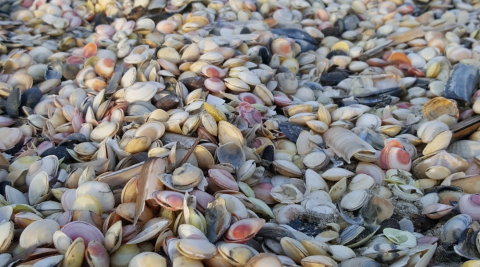Baltic tellin most common bivalve at the fourth Belgian Big Seashell Survey
Oostende (2021.03.17) - The Big Seashell Survey 2021 - a unique citizen science initiative on Belgian beaches that took place last Sunday 14 March - was a top edition! The Baltic tellin accounted for almost 30% of all shells found, followed by the cut trough shell (23%) and the common cockle (19%). Two-thirds of all Baltic tellins was found as whole shells, composed of two hinged parts of valves, indicating a recent death, possibly due to the stormy conditions during the past weeks.

Press release by: Flanders Marine Institute (VLIZ)
Last weekend, the fourth edition of the Big Seashell Survey took place along the Belgian coast as part of the LifeWatch programme. This citizen science initiative is organised by the Flanders Marine Institute (VLIZ), EOS, Natuurpunt, the Province of West Flanders, the Strandwerkgroep, Kustererfgoed and the ten coastal municipalities.
For the first time, also primary schools could participate in the data collection in the week prior to the counting weekend. Under the impetus of the Province of West Flanders, nature guides were involved to assist in the identification of the shells by the children.
All together, at least 1100 people took part, of which 600 citizens during the weekend and 500 pupils from twenty primary schools in the week before. Together they counted and identified 40.000 shells (schools: 15.000; citizens: 25.000), the second highest score since the initiative was launched in 2018.
Of the 47 species encountered, for the first time the Baltic tellin appeared to be the most numerous one with 29% of all shells found. The rest of the top-6 remained unchanged with cut trough shell (23%), cockle (19%), mussel (10%), banded wedge shell (4%) and Atlantic jackknife clam (3%).
Striking were the many freshly washed up whole Baltic tellins, the halves still joined by a ligament. This points to a recent die-off in the shallow coastal waters - the habitat of the species – after which they washed up ashore. The massive beaching of these Baltic tellins can possibly be linked to the rough weather conditions of the past weeks. The percentage of whole - read "fresh" - shells was high for the pullet carpet Shell (70%), the mussels (63%) and the Atlantic jackknife clam (57%) as well.
This is in sharp contrast to the cut trough shells or cockles, in which whole shells occurred in only 2% of all specimens. Shells of these two species found on the Belgian beaches are mainly fossils. As witnesses of a distant past, their shell valves have been separated over time.
During this corona proof edition of the Big Seashell Survey, there were no fixed stations on the beach where experts could help the participants in collecting and identifying the samples. Instead, a digital helpdesk provided distant support. This allowed the experts to validate three quarters of all collected shells, either through an online connection with the citizen-collector, or based on shared photos.

Press contact: Jan Seys - press officer VLIZ: jan.seys@vliz.be | +32-(0)478-37 64 13
Read the original press releases here (EN) and here (NL).
Last weekend, the fourth edition of the Big Seashell Survey took place along the Belgian coast as part of the LifeWatch programme. This citizen science initiative is organised by the Flanders Marine Institute (VLIZ), EOS, Natuurpunt, the Province of West Flanders, the Strandwerkgroep, Kustererfgoed and the ten coastal municipalities.
For the first time, also primary schools could participate in the data collection in the week prior to the counting weekend. Under the impetus of the Province of West Flanders, nature guides were involved to assist in the identification of the shells by the children.
All together, at least 1100 people took part, of which 600 citizens during the weekend and 500 pupils from twenty primary schools in the week before. Together they counted and identified 40.000 shells (schools: 15.000; citizens: 25.000), the second highest score since the initiative was launched in 2018.
Of the 47 species encountered, for the first time the Baltic tellin appeared to be the most numerous one with 29% of all shells found. The rest of the top-6 remained unchanged with cut trough shell (23%), cockle (19%), mussel (10%), banded wedge shell (4%) and Atlantic jackknife clam (3%).
Striking were the many freshly washed up whole Baltic tellins, the halves still joined by a ligament. This points to a recent die-off in the shallow coastal waters - the habitat of the species – after which they washed up ashore. The massive beaching of these Baltic tellins can possibly be linked to the rough weather conditions of the past weeks. The percentage of whole - read "fresh" - shells was high for the pullet carpet Shell (70%), the mussels (63%) and the Atlantic jackknife clam (57%) as well.
This is in sharp contrast to the cut trough shells or cockles, in which whole shells occurred in only 2% of all specimens. Shells of these two species found on the Belgian beaches are mainly fossils. As witnesses of a distant past, their shell valves have been separated over time.
During this corona proof edition of the Big Seashell Survey, there were no fixed stations on the beach where experts could help the participants in collecting and identifying the samples. Instead, a digital helpdesk provided distant support. This allowed the experts to validate three quarters of all collected shells, either through an online connection with the citizen-collector, or based on shared photos.

Press contact: Jan Seys - press officer VLIZ: jan.seys@vliz.be | +32-(0)478-37 64 13
Read the original press releases here (EN) and here (NL).



